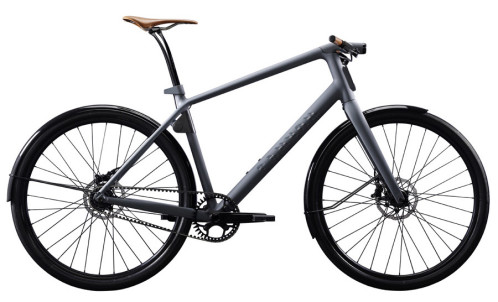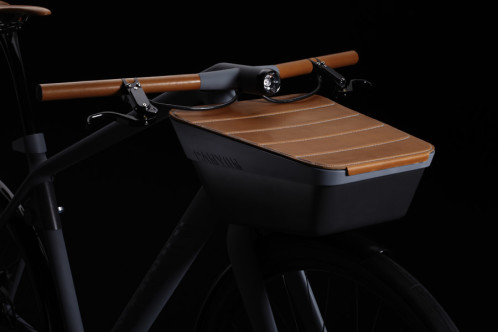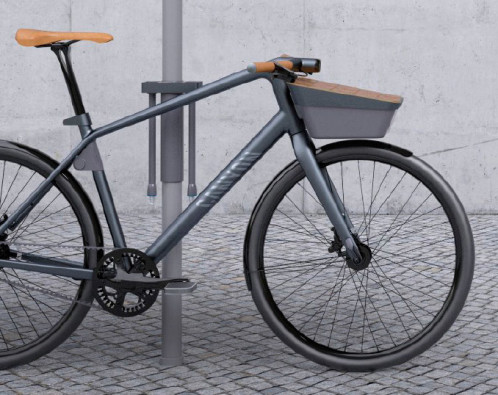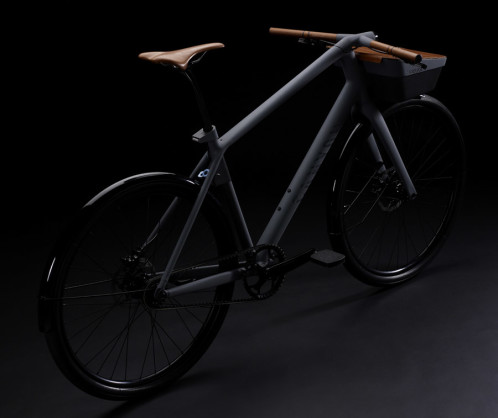 Eurobike came to a close over the weekend in Friedrichshafen, Germany, and I have seen a few interesting concept bike designs from the show. One of my favorites is by German brand Canyon, well known for their race oriented roads bikes and the red dot award winning Speedmax time trial machine. The concept bike that Canyon debuted last week is not geared exclusively toward the racing crowd though. Instead, it is a 2 speed belt drive urban bike with features such as integrated lights, an integrated locking system, mudguards, non slip flat pedals, hydraulic disc brakes, a removable shopping basket, and much more. This is definitely an urban bike with a sporty side though. They point out that “the central challenge was to transfer characteristics such as competitiveness, great design and functionality so typical of the Canyon brand to an urban product range.”
Eurobike came to a close over the weekend in Friedrichshafen, Germany, and I have seen a few interesting concept bike designs from the show. One of my favorites is by German brand Canyon, well known for their race oriented roads bikes and the red dot award winning Speedmax time trial machine. The concept bike that Canyon debuted last week is not geared exclusively toward the racing crowd though. Instead, it is a 2 speed belt drive urban bike with features such as integrated lights, an integrated locking system, mudguards, non slip flat pedals, hydraulic disc brakes, a removable shopping basket, and much more. This is definitely an urban bike with a sporty side though. They point out that “the central challenge was to transfer characteristics such as competitiveness, great design and functionality so typical of the Canyon brand to an urban product range.”
 You can read more about the Canyon urban concept on the Eurobike 2013 section of their website. With this post though, I just want to spotlight a few of the features that initially interested me when I saw the design.
You can read more about the Canyon urban concept on the Eurobike 2013 section of their website. With this post though, I just want to spotlight a few of the features that initially interested me when I saw the design.
 Integrated front and rear LED lights are a detail that we are seeing more and more often on transportation focused bike concepts. In this case, I like the way that the front light is an extension of the stem/handlebar assembly, which in turn is nicely integrated into the shape of the frame (similar to a LOOK 675 or similar frame design). The rear lights are found in the seatpost clamp, and according to Canyon, power to both is supplied by a “plugless SON hub dynamo, which transfers power via the fork drop-outs.”
Integrated front and rear LED lights are a detail that we are seeing more and more often on transportation focused bike concepts. In this case, I like the way that the front light is an extension of the stem/handlebar assembly, which in turn is nicely integrated into the shape of the frame (similar to a LOOK 675 or similar frame design). The rear lights are found in the seatpost clamp, and according to Canyon, power to both is supplied by a “plugless SON hub dynamo, which transfers power via the fork drop-outs.”
 The click-in removable front basket is another nice feature. It looks good on the bike, and when removed can be used as a shopping basket, complete with a handle, as shown in the illustration below. If this bike were to become a real product, I would imagine that different sized accessory baskets and platforms could be offered to mate with the frame.
The click-in removable front basket is another nice feature. It looks good on the bike, and when removed can be used as a shopping basket, complete with a handle, as shown in the illustration below. If this bike were to become a real product, I would imagine that different sized accessory baskets and platforms could be offered to mate with the frame.
 A big part of this concept bike is the anti-theft device, which is more than just a lock. Though a locking mechanism is built into the frame at the seat tube junction, the full solution is based on an infrastructure based concept (Canyon notes that this concept is “all about sounding out possibilities and ideas with the involvement of local councils and communities.”). In order for the locking system to work, chains or cables would need to be part of the urban infrastructure. They envision that “local councils can provide locking systems on road signs and lamp posts, businesses and restaurants can provide further bike stands for their customers, employers for their employees and every individual at home for his bike.”
A big part of this concept bike is the anti-theft device, which is more than just a lock. Though a locking mechanism is built into the frame at the seat tube junction, the full solution is based on an infrastructure based concept (Canyon notes that this concept is “all about sounding out possibilities and ideas with the involvement of local councils and communities.”). In order for the locking system to work, chains or cables would need to be part of the urban infrastructure. They envision that “local councils can provide locking systems on road signs and lamp posts, businesses and restaurants can provide further bike stands for their customers, employers for their employees and every individual at home for his bike.”
 Beyond the lock idea, there is a QR code on the frame that allows for online registration and identification. Unless the QR pattern is removed, it can be easily checked with a Smartphone so that a prospective buyer could determine if the bike is stolen. There are not many details on that system at this point, but it seems like a good starting point for a registration system at least…somewhat similar to Cyclingboom and other like systems. In the event that the locking and online registration systems both fail, Canyon would offer a reduced replacement price for unrecoverable stolen bikes.
Beyond the lock idea, there is a QR code on the frame that allows for online registration and identification. Unless the QR pattern is removed, it can be easily checked with a Smartphone so that a prospective buyer could determine if the bike is stolen. There are not many details on that system at this point, but it seems like a good starting point for a registration system at least…somewhat similar to Cyclingboom and other like systems. In the event that the locking and online registration systems both fail, Canyon would offer a reduced replacement price for unrecoverable stolen bikes.
Now that the initial presentation at Eurobike is over, Canyon wants to “share and discuss the concept with as many people as possible.” Leave a comment, and let let them know what you think of the design… and the idea of linking it to new infrastructure projects in local communities.




Leave a Reply to Nicholas Hardrath Cancel reply